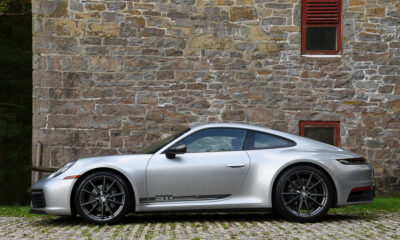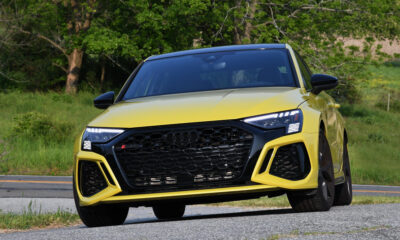
Photo: David Haueter
Aston Martin has been around for 110 years now, and racing has always been a part of the company DNA.
Aston Martin cars were raced from the earliest days of the company and that tradition continues today, not only in Formula 1 but in sports car racing with the Vantage GT3 and GT4 models and a forthcoming Valkyrie-based Hypercar.
That racing pedigree carries over to the road cars as well, with models like the Vantage F1 Edition.
The Vantage sits at the bottom of the Aston Martin car lineup (not counting the DBX SUV), which also includes the DB12 and DBS, as well as more specialized models like the Valour and Valhalla.
You can get the Vantage in a few different flavors, with the V8 Coupe and Roadster as well as a V12 Coupe or Roadster. The F1 Edition celebrates Aston Martin’s F1 participation as a manufacturer and is based on the V8 Coupe.
The Vantage V8 Coupe is a great base to start with. It puts out 503 horsepower and 505 foot-pounds of torque from its four-liter twin-turbo V8.
The F1 Edition bumps the power up to 527 hp with the same torque output and can reach 60mph in a very quick 3.5 seconds, just a tenth faster than the standard Coupe.
Incidentally, the V8 in the Vantage models is sourced from Mercedes-Benz, which has a stake of around 10 percent in Aston Martin.

Photo: David Haueter
The Vantage engine is the same one used in Mercedes-AMG models, but it still has a badge on the top of the engine that says it’s “hand built in Great Britain,” which is a stretch but is kind of true since Aston Martin gives the engines a final check over before assembling and installing them. The engine in our car had a final inspection from Luke Wensley at Aston Martin in the UK.
Buyers of the Vantage F1 Edition likely won’t notice any difference in power versus the regular Vantage, but Aston Martin did make significant upgrades to tell them apart visually.
There’s a lot more aero on the F1 Edition, with a prominent rear wing and a front splitter and dive planes in addition to the rear diffuser that’s also on the standard car. There are even underbody turning vanes on the F1 Edition to help suck the car onto the road, and it all works.
Aston Martin says the aero on the F1 Edition gives it 200 kg more downforce than the standard Vantage at top speed, which is 195 mph.
Aston Martin also worked to improve handling and responsiveness in the F1 Edition, with increased front structural stiffness, increased rear spring rate and lateral stiffness, and reworked dampers to help improve vertical body control.
The suspension itself is a double-wishbone setup in the front and a multi-link setup at the rear, with coil springs and anti-roll bars on both ends. The dampers are also adaptive and give the driver choices for Sport, Sport Plus and Track.
The Vantage F1 Edition uses the same rear mid-mounted ZF eight-speed automatic as the regular car but is programmed with an optimized torque cut on upshifts to reduce shift times and give the driver a more direct feel, while also enhancing control on downshifts.
The electronic differential is also programmed differently than in the standard coupe, and 21-inch wheels are standard, wearing Pirelli P Zero tires. The brake rotors measure 15.7 inches up front and 14.2 inches at the rear, and our test car had the optional carbon ceramic brakes ($11,700).

Photo: David Haueter
Inside, the F1 Edition has a lot of Alcantara, with the material spread amply over the doors, seats, center tunnel, the lower part of the dash, the steering wheel and even the top of the instrument binnacle.
Our car also had the optional Alcantara headliner ($2,000). There’s also plenty of carbon fiber trim as well on the dash as well, and our test car also had the optional carbon fiber lightweight seats ($6,500). With all the options, our test car’s MSRP came out to $207,686, up from a base price of $175,200.
All Vantage models are fantastic to look at, but the aero on the F1 Edition car certainly gives it more street presence. It’s hard to miss that big rear wing, and the body color diffuser elements on our test car made the rear end look very aggressive.
I would actually prefer the diffuser in black, but the Vantage has a timeless and enduring design that is instantly recognizable as an Aston Martin. This car is still going to look great in 50 years.
The car seems a bit behind the times in some ways on the inside, with a last-generation Mercedes-sourced infotainment system with a screen that seems downright small in comparison to other cars.
There’s a lot of buttons and knobs in the center console, including pushbuttons for gear selection, but once you learn what they do and get used to where they are they’re easier to use than going three levels deep on a screen to perform basic functions.
Push the starter button and this car signals its intentions with a loud rumble from the V8 when it turns over.
The lightweight carbon fiber racing seats are surprisingly comfortable while holding you firmly in place and the view through the somewhat oddly shaped steering wheel is right at the tachometer, which is as it should be. The paddles for manual shifting are also prominent and upright, not hidden behind the steering wheel.

Photo: David Haueter
Like other great sports cars, the Vantage F1 Edition works better when you’re pushing it and driving harder than it does ambling around town.
It can handle the more mundane tasks of getting from one point to another with no problems, but it kind of feels like a race horse that wants to be run freely and feels so much more connected and in harmony with the driver when you’re going for it on a twisty stretch of road, even though it weighs in at a hefty 3,461 pounds.
This car likes to be driven hard and the suspension in particular just seems to work better while handling more abrupt changes in direction, with fantastic grip when negotiating corners and great power delivery when storming out of them. The suspension gives a firm ride, but it’s tuned beautifully for twisty roads that have undulations and bumps, delivering great control and precision.
The transmission is at its best in manual mode using the paddles, as it tends to hunt around too much in automatic mode when driving around town, and the brakes work better when they’re generating some heat and are being used more aggressively.
I would love to take this car on a track, as it seems like that is its natural environment. Of course, Aston Martin built this car to also be used as an F1 pace car, and the car looks very well composed and planted when leading the F1 cars around during cautions. I’m sure Bernd Maylander appreciates the attention that Aston put into it.
As for me, I would be happy to own any of the Vantage models. It’s one of the most beautiful sports car designs today and gives you a sense of occasion whenever you’re in it, and it’s more exclusive and rarer than other cars in this segment.

Photo: David Haueter


























